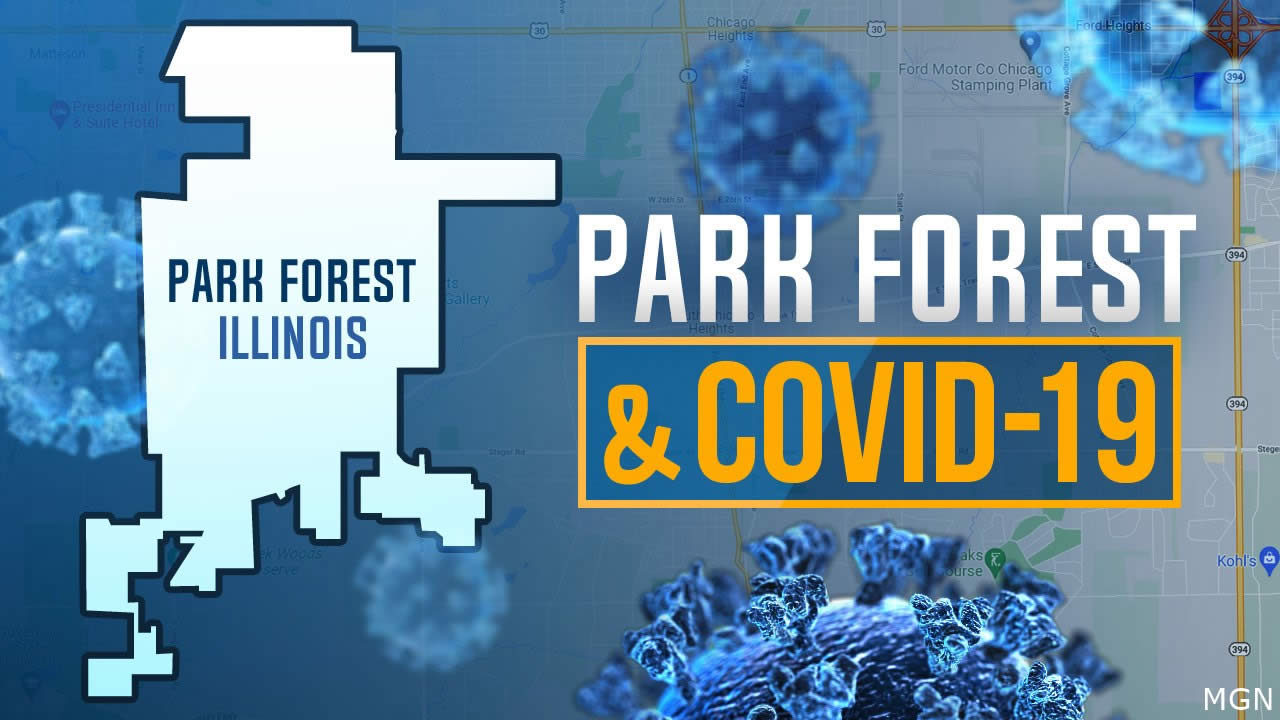
Park Forest, IL-(ENEWSPF)- The latest figures for the 30 towns we survey during the COVID-19 pandemic show a bit of a leveling off, both in the number of cases and the number of deaths. The number of deaths did increase by one or two in some towns in the region, but not in Park Forest, where the count remains at 20.
South Chicago Heights is the only one of the 30 towns we track that has not lost a single person to COVID-19.
The overall recovery rate in Illinois is holding at 94%, just where it was when we last surveyed figures on June 26. However, the Institute for Health Metrics and Evaluation (IHME), an independent global health research center at the University of Washington, now predicts upwards of 208,255 people in the United States will die of the virus by October 1, 2020, an increase in expectations of 201,000 on June 20.
Since that time, the virus has taken a stronghold in Texas, Georgia, Florida, Arizona, and South Carolina. The Washington Post reports that “many Texas hospitals are struggling to add capacity to treat both COVID-19 patients and others.”
The New York Times reports, “There is no country in the world where confirmed coronavirus cases are growing as rapidly as they are in Arizona, Florida or South Carolina. The Sun Belt has become the global virus capital.” (via Chicago Tribune)
Cicero still tops the list of the 30 towns we survey with 3038 people testing positive for COVID-19, now at 3621.04 people per 100,000.
Cicero has lost 79 people to the virus. That number has not changed since we last surveyed.
The number of cases in the region is still rising but not nearly as steeply, this with increased testing too.
IHME projects 8907 deaths in Illinois by November 1, 2020. Daily deaths, however, continue to decline and are projected to continue declining through October 1, picking up slightly through October to November 1.
Park Forest currently has 519 known cases of the disease with a rate of 2421.95 per 100,000 people, still the second-highest rate of the towns we survey and still the tenth highest rate in all of Cook County.
According to the state of Illinois, Ludeman Center in Park Forest has 223 residents who tested positive for COVID-19, up from 220 when we last surveyed. Of these 223 residents who tested positive, 215 have recovered. That’s ten more recovered residents since we last checked.
A total of 126 staff members at Ludeman have tested positive, one more since we last surveyed. However, of these, 118 have recovered and returned to work, two more than when we last surveyed.
Are you experiencing mental health issues related to COVID-19? Text “TALK” or “HABLAR” to 552020 to receive support from a counselor in your local community.
As of June 29, no Ludeman Homes at all were being supported in droplet isolation. This refers to precautions healthcare workers, visitors, and staff need to take “before going into or leaving a patient’s room.”
That is incredibly good news.
“Droplet precautions are for patients who have germs that can spread when they cough or sneeze.” (MyHealth.Alberta.CA)
Ludeman Center employs 911 people and has 339 residents, according to the current census. All have been tested, some twice, according to Parents & Friends. Staff continues to undergo wellness checks before reporting to their respective assignments, the group Parents & Friends reports.
Twenty (20) people from Park Forest have died of COVID-19 related issues according to the Cook County Medical Examiner‘s office. That number is unchanged since we last checked the figures.
A total of 4219 people in Park Forest have been tested with an overall positive test percentage of 12.30%, down from 13.64% when we last surveyed.
The Will County Health Department reports 44 cases of COVID-19 in the Will County section of Park Forest as of July 10, 2020. That figure is one higher since we last surveyed.
As of this writing, Chicago Heights has 644 confirmed cases and a rate of 2127.40 per 100k. Steger has 103 cases, Flossmoor 95, Richton Park 231, Olympia Fields has 66, Sauk Village 129, Glenwood 194, Tinley Park 375, and South Chicago Heights has 98.
Harvey has 533 cases, Country Club Hills has 362 cases, Orland Park 584, Lynwood 137, Lansing 447, Homewood 304, South Holland 479, Markham 252, and Crete 193.
Ford Heights holds again at 35 cases, and Calumet City has 671 and a rate of 1811.46 per 100,000 people.
Currently, IDPH is reporting a total of 151,767 cases, including 7,144 deaths, in 102 counties in Illinois. The age of cases ranges from younger than one to older than 100 years. Within the past 24 hours, laboratories have reported 32,987 specimens for a total of 1,911,743.
The preliminary seven-day statewide positivity for cases as a percent of total test from July 3 –July 9 is 2.9%.
As of last night, 1,436 people in Illinois were reported to be in the hospital with COVID-19. Of those, 306 patients were in the ICU and 155 patients with COVID-19 were on ventilators.
As of June 26, 2020, there are a total of 37,063 confirmed cases of COVID-19 in suburban Cook County and 1,723 deaths; only 177 cases are in congregate settings, such as long term care facilities or nursing homes, are reporting one or more confirmed cases. 43 cases are in other settings, such as workplaces or large gatherings, with confirmed outbreaks; with a total of 329 outbreak-associated cases.
The data from Cook County includes all cases under the jurisdiction of the Cook County Department of Public Health (excludes Chicago, Evanston, Oak Park, Skokie, and Stickney Township). All numbers are provisional and subject to change.
As of this writing, Will County now reports 7,176 confirmed cases and 324 deaths.
We note again: Other countries have fewer cases of COVID-19, far lower rates per 100k. The higher numbers are not an inevitability of testing. Testing alone is not the determining factor in higher numbers.
We leave further interpretation of the data up to our astute readers.
Deceased from COVID-19
The Cook County Medical Examiner now reports 4,724 total COVID-19 related deaths since March 16, 2020, as of July 10, 2020.
As noted above, Park Forest has lost 20 people from COVID-19.
The number of deceased from Chicago Heights is now 34, one more person than when we last tallied. Cicero lost 79; Richton Park 14, one more since our last tally; Matteson 24, one more here too; and Country Club Hills 34, also one more person deceased since our last tally. The number of deaths in Steger (Cook County) is 4, unchanged since we last tallied. Crestwood has now lost 20 (+1), and Homewood has now lost 32 (+1).
COVID-19 Deaths for 30 Towns
| Municipality | Total Deceased | Most Recent Population Figures | Rate per 100,000 Population*
|
| Calumet City | 5 | 37042 | 13.50 |
| Chicago Heights | 34 | 30276 | 112.30 |
| Cicero | 79 | 83889 | 94.17 |
| Country Club Hills | 34 | 16541 | 205.55 |
| Crestwood | 20 | 10950 | 182.65 |
| Crete | 5 | 8117 | 61.60 |
| Dolton | 22 | 23153 | 95.02 |
| East Hazel Crest | 3 | 1543 | 194.43 |
| Flossmoor | 9 | 9464 | 95.10 |
| Ford Heights | 1 | 2763 | 36.19 |
| Frankfort | 4 | 19178 | 20.86 |
| Glenwood | 6 | 8969 | 66.90 |
| Harvey | 21 | 25282 | 83.06 |
| Hazel Crest | 16 | 14100 | 113.48 |
| Homewood | 32 | 19323 | 165.61 |
| Lansing | 11 | 28331 | 38.83 |
| Lynwood | 2 | 9007 | 22.20 |
| Markham | 15 | 12508 | 119.92 |
| Matteson | 24 | 19009 | 126.26 |
| Oak Forest | 8 | 27962 | 28.61 |
| Olympia Fields | 4 | 4988 | 80.19 |
| Orland Park | 34 | 56582 | 60.09 |
| Park Forest | 20 | 21429 | 93.33 |
| Richton Park | 14 | 13646 | 102.59 |
| Sauk Village | 2 | 10506 | 19.04 |
| South Chicago Heights | 0 | 4139 | 0.00 |
| South Holland | 31 | 22030 | 140.72 |
| Steger | 4 | 9331 | 42.87 |
| Tinley Park | 9 | 49235 | 18.28 |
| University Park | 5 | 6958 | 71.86 |
| Combined | 474 | 606251 | 78.19 |
*Numbers per 100,000 based on most recent population from US Census.gov or derived via formulat using rate per 100,000 population and COVID-19 cases as reported by Cook County. |
|||
The City of Chicago has lost 2,544 people to COVID-19, 96 more people since we last tallied.
As previously mentioned, the state of Illinois reports an overall recovery rate of 94%. According to the IDPH, the recovery rate is calculated as the recovered cases divided by the sum of recovered cases and deceased cases. Recovered cases are defined as persons “with an initial positive specimen collection date” who after more than 42 days “have not expired,” according to the IDPH.
Current COVID-19 Cases for 30 South Suburban Towns
| Municipality | COVID-19 Cases | Most Recent Population Figures | Rate per 100,000 Population* |
| Calumet City | 671 | 37042 | 1811.46 |
| Chicago Heights | 644 | 30276 | 2127.10 |
| Cicero | 3038 | 83889 | 3621.45 |
| Country Club Hills | 362 | 16541 | 2188.50 |
| Crestwood | 138 | 10950 | 1260.27 |
| Crete | 193 | 8117 | 2377.73 |
| Dolton | 445 | 23153 | 1922.00 |
| East Hazel Crest | 17 | 1543 | 1101.75 |
| Flossmoor | 95 | 9464 | 1003.80 |
| Ford Heights | 35 | 2763 | 1266.74 |
| Frankfort | 198 | 19178 | 1032.43 |
| Glenwood | 194 | 8969 | 2163.01 |
| Harvey | 533 | 25282 | 2108.22 |
| Hazel Crest | 225 | 14100 | 1595.74 |
| Homewood | 304 | 19323 | 1573.25 |
| Lansing | 447 | 28331 | 1577.78 |
| Lynwood | 137 | 9007 | 1521.04 |
| Markham | 252 | 12508 | 2014.71 |
| Matteson | 404 | 19009 | 2125.31 |
| Oak Forest | 268 | 27962 | 958.44 |
| Olympia Fields | 66 | 4988 | 1323.18 |
| Orland Park | 584 | 56582 | 1032.13 |
| Park Forest | 519 | 21429 | 2421.95 |
| Richton Park | 231 | 13646 | 1692.80 |
| Sauk Village | 129 | 10506 | 1227.87 |
| South Chicago Heights | 98 | 4139 | 2367.72 |
| South Holland | 479 | 22030 | 2174.31 |
| Steger | 103 | 9331 | 1103.85 |
| Tinley Park | 375 | 49235 | 761.65 |
| University Park | 135 | 6958 | 1940.21 |
| Combined | 11319 | 606251 | 1867.05 |
*Numbers per 100,000 based on most recent population from US Census.gov or derived via formulat using rate per 100,000 population and COVID-19 cases as reported by Cook County. |
|||
The following chart will auto-update as we update our Google spreadsheet:
Overall for the State of Illinois
The Illinois Department of Public Health (IDPH) today announced 1,317 new confirmed cases of coronavirus disease (COVID-19) in Illinois, including 25 additional confirmed deaths.
- Cass County: 1 female 80s
- Cook County: 3 females 60s, 2 males 60s, 1 unknown 60s, 3 females 70s, 2 males 70s, 2 females 80s, 1 male 80s, 1 female 90s, 1 male 90s
- DuPage County: 1 male 70s
- Lake County: 1 female 70s
- McHenry County: 1 female 80s
- Peoria County: 1 female 90s
- Will County: 1 female 70s
- Winnebago County: 1 male 60s, 2 males 80s
Currently, IDPH is reporting a total of 151,767 cases, including 7,144 deaths, in 102 counties in Illinois. The age of cases ranges from younger than one to older than 100 years. Within the past 24 hours, laboratories have reported 32,987 specimens for a total of 1,911,743. The preliminary seven-day statewide positivity for cases as a percent of total test from July 3 –July 9 is 2.9%. As of last night, 1,436 people in Illinois were reported to be in the hospital with COVID-19. Of those, 306 patients were in the ICU and 155 patients with COVID-19 were on ventilators.
Following guidance from the Centers for Disease Control and Prevention, IDPH is now reporting both confirmed and probable cases and deaths on its website. Reporting probable cases will help show the potential burden of COVID-19 illness and efficacy of population-based non-pharmaceutical interventions. IDPH will update these data once a week.
*All data are provisional and will change. In order to rapidly report COVID-19 information to the public, data are being reported in real-time. Information is constantly being entered into an electronic system and the number of cases and deaths can change as additional information is gathered. For health questions about COVID-19, call the hotline at 1-800-889-3931 or email [email protected].
About the Elisabeth Ludeman Center
As of June 17, the Illinois Department of Human Services reports a current census of 339 residents at Ludeman Center. Of these:
- The average age is 53.4 years (22 – 77);
- 72% of the residents are severe and profound mentally, intellectually, and physically disabled.
- 52% are non-verbal, using sign language or gestures to communicate;
- 58% have a behavior intervention program, often requiring higher
levels of staff supervision; - 63% receive psychotropic medications.
The Elisabeth Ludeman Center occupies 60 acres in Park Forest at the southwest corner of Orchard Drive and North Street.
The Center is divided into three (3) residential units comprised of 13-14 homes. Each unit has a centrally located Neighborhood House which has offices for the Unit Director, Social Worker, Unit Physician, Nursing Personnel, Qualified Intellectual Disabilities Professionals, (QIDP’s), Residential Services Supervisors and clerical personnel. The Ludeman Center also serves as an admission center for individuals having significant adaptive issues in the community-based setting. The Interdisciplinary teams’ main priority is to stabilize and ensure a successful transition back into the community.
Each of the 40 ranch-style homes has a kitchen, dining/living room area, utility room which contains a washer and dryer, two full and one half bathrooms, and five bedrooms.
Approximately half of the people who currently reside at the Ludeman Center attend vocational training programs at community training sites or workshops. The remainder of the people are served in on-campus day training programs. Currently, several individuals are working in a food service program, housekeeping program, horticulture program (vegetable garden and greenhouse flowers) and in the Center-wide recycling program.
Finally, the Ludeman Center has opened its doors and shared space/services with the Illinois Department Of Transportation’s District 1 South DBE Resource Center; as well as the Office of the Inspector General, Bureau of Civil Affairs, Bureau of Quality Management, and SODC Operations.
*Why Rate Per 100,000?
We found a clear explanation for viewing the rate of infections per 100,000 comes from Indiana University at Bloomington: “There may or may not be 100,000 residents in the county under review, but multiplying the result by 100,000 makes that rate comparable with counties with more than 100,000 or less than 100,000.”
“It is customary to use rates per 100,000 population for deaths and rates per 1,000 population for live births,” our source at Indiana University says.
So, none of the cities, towns, and villages we survey have 100,000 residents, but by using the rate per 100,000, we are able to compare apples to apples, so to speak, as if every town did have 100,000 residents.
eNews Park Forest will continue to track the effects the COVID-19 pandemic has on our region.








